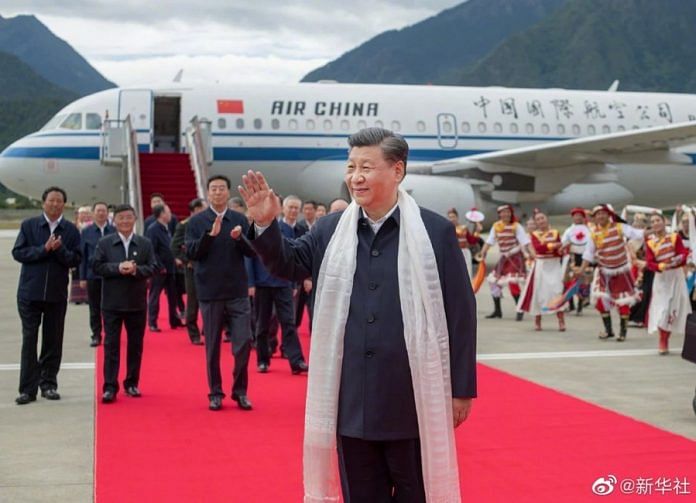New Delhi: After more than a decade, Chinese President Xi Jinping visited Tibet’s capital Lhasa and Gongbo’gyamda county.
China’s official news agency Xinhua reported Xi arrived in Lhasa Thursday.
Video clips shared on social media showed Xi, Wu Jingjie, Tibet Party Secretary, and Che Dalha, Chairman of the Tibetan Autonomous Region along with a few other officials in the regional capital.
Videos also showed Xi driving through the Tibetan quarter of Lhasa, and addressing the public in front of the Potala Palace, the former winter residence of the exiled Dalai Lama.
“As long as we follow the Communist Party, as long as we adhere to the path of socialism with Chinese characteristics, we will surely be able to achieve the great rejuvenation of the Chinese nation…,” Xi said while interacting with the public at Potala Square.
“…all ethnic groups all over Tibet were marching towards a happy life in the future. We are as full of confidence as you,” Xi can be heard saying in another video posted by Robert Barnett, a Tibetan studies expert at the University of London.
According to a source, ahead of Xi’s visit, the Potala Committee had announced that the region would be closed to the public on 22 July. A ban on flying drones and kites was also in place.
A source also said a small group of officials was informed about the holiday.
“Unconfirmed reports say a major ceremony will take place in Lhasa on July 25, presumably to mark the 70th Anniversary of the 1951 ‘Peaceful Liberation,” said Barnett.
According to Xinhua, Xi also visited Nyingchi Mainling Airport in Mainling, Nyingchi Prefecture, the Tibetan town near Arunachal Pradesh.
#XiJinping visits the city of Nyingchi in southwest China's #Tibet Autonomous Region https://t.co/lnBMpEOo7s pic.twitter.com/TvtLlDRGHT
— China Xinhua News (@XHNews) July 23, 2021
He also inspected Yarlung Zangbo, the upper stream of the Brahmaputra river, located in the Tibetan Autonomous Region, and the Linzhi Railway Station as part of the Sichuan Tibet Railway project.
The visit comes at a time when India and China are locked in a military stand-off in Eastern Ladakh.
Also read: US shifting its Tibet stance. When will India end its silence?
Xi’s 2011 visit
The Chinese President had last visited Lhasa on 21 July 2011, before succeeding the then president Hu Jintao. The 2011 visit marked 60 years of China’s “Peaceful Liberation of Tibet”.
This year marks the 70th anniversary of China’s occupation of Tibet. It also marks 100 years of the Chinese Communist Party.
During his 2011 visit, Xi had said: “[We] should thoroughly fight against separatist activities by the Dalai clique by firmly relying on all ethnic groups… and completely smash any plot to destroy stability in Tibet and jeopardise national unity.”
Visit sparks rumours on China’s plans for Tibet
Xi’s visit is likely to fuel speculation on the Chinese Communist Party’s plans after the reincarnation of the 14th Dalai Lama.
In May 2021, China published a white paper titled “Tibet Since 1951: Liberation, Development and Prosperity”, which provides insight into China’s plans for the region.
“The ordinance stipulated that the reincarnation of the Dalai Lama and other grand Living Buddhas had to follow the procedure of “drawing lots from the golden urn”, and the selected candidate would be subject to approval by the central government of China,” says the white paper.
China already used the “Golden Urn” in 1995 to appoint its own Panchen Lama.
“In 1995, with the approval of the State Council, the search for and identification of the reincarnation of the 10th Panchen Lama and the enthronement of the 11th Panchen Lama were completed by drawing lots from a golden urn”, the 2021 white paper adds.
The Wall Street Journal recently reported that Beijing had placed new restrictions on “Tibetan religion, education and language while increasing its ability to keep constant watch over individuals.”
“To the north, monks at the 127-year-old Xin Monastery say new restrictions on youth participation are making it hard to bring in recruits. Across the region, schools are slashing recruitment of teachers who give classes in Tibetan and replacing traditional artwork with posters of Chinese leaders,” the report said.
Tibet is also at the heart of Xi’s poverty alleviation campaign, which involves building houses for Tibetan families. Some of the resettlement projects are incredibly close to the border with India in Eastern Ladakh, Sikkim and Arunachal Pradesh. China has also built new villages well inside Bhutan’s territory.
The construction has raised concern in New Delhi about China’s long-term border policy.
In August 2020, Xi Jinping asked party officials and military leaders to “solidify border defences and ensure frontier security” and ensure “national security and enduring peace and stability” along the border with India.
Also read: Modi must consolidate Dalai Lama legacy as Xi’s grip on Tibet gets tighter



